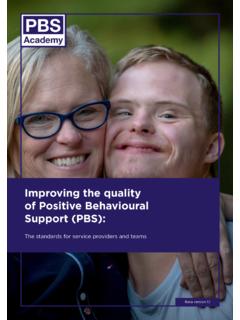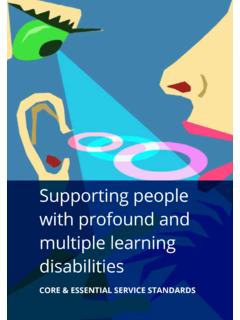Transcription of Learning Disabilities since 1900 - janwalm | Welcome
1 Learning Disabilities since 1900 Jan WalmsleyProfessor, History of Learning Disabilities , Open UniversityAbout me Founded Social History of Learning Disability Research Group at Open University in 1994 Community Care in Perspective (2006) Towards a Good Life for People with Intellectual Disabilities (2010) People, Places, Policy: Learning Disabilities in the Twentieth Century (in preparation)Today Inclusion Closure of specialist services 3000 people in inpatient care, mostly private Transforming CareDeaths austerityBut some things constant ..Families Vulnerability Ely Hospital 1969 Winterbourne View 2011 Eugenic concernsMoneyWorkforceWho are we talking about? People with a significantly reduced ability to understand new or complex information, to learn new skills (Department of Health 2001) Approximately million people in England in 2011, 905,000 adults aged 18+, 503,000 men and 375000 women (People with ldin England 2011) adults in employment, most part-time Between 25% and 40% also have mental health problems High rates of epilepsy Life expectancy for men is 63, for women 60 (CIPOLD 2013)
2 Fewer than 50% have an Annual Health CheckMeeting the challenge of supporting people who require help to manage their livesInstitutions 1913 Mental Deficiency Act Segregation in colonies, with families, in supervised employment Discourse of threat and criminality, shading into medical from late 1930sCare in the Community 1959 MH Act, 1971 White Paper Better Services for the Mentally Handicapped Integration hostels, day centres, care in, by, or with the community Discourse of care Rights, Independence, Choice, Inclusion 2001 Valuing People Social inclusion self directed support, supported living, use of mainstream services Discourse of rights Key dates 1913 Mental Deficiency Act 1929 Wood Committee 1936 Brock Committee 1946 NHS took over 1959 Mental Health Act 1970 Education Act 1971 Better Services White Paper 1979 Jay Report 2001 Valuing People White Paper 2010 Orchard Hill closure Initiated institutionalisation Flowing pool not stagnant lake Rejected compulsory sterilisation Medical model of care Start of care in community Everyone entitled to education Run down of hospitals advocated Argued for a new workforce Independence, choice, rights.
3 Inclusion In theory last NHS ldhospital to close Changing labels1913 Mental Defective Feeble minded Idiot Imbecile Moral Defective Mongol21stcentury Learning disability Learning difficulty Intellectual disability Special needs Autism Downs SyndromeA period of change?From thisTo thisWhy institutions? Fear of feeble-minded US psychologist Henry H. Goddard (1866-1957) affirmed that feeble-minded people were "multiplying at twice the rate of the general population," (1912, p. 71) thus producing "more feeble-minded children with which to clog the wheels of human progress" (1912, p. 78)Why institutions: Impulse to care Remove people from workhouses and lunatic asylums Save them from neglectful families and unwelcoming communities Offer asylum Provide training The lad would benefit from training as there is no mother, and he is left alone a good deal (1936)Tests for mental retardation Age 14 State the differences between a king and a president , power, tenure, accession (Two out three to score.)
4 Arithmetical reasoning. If a man has 20 a week and spends 18 a week, how long will it take to save 20? If two pencils cost 60p., how many can you buy for 6 ? At an metre how much will 2metres 33cm costs? (Two out of three to pass) Induction test, folded paper x 8*. What was the original size of paper? Give the meanings of fifty words. Word sheet supplied Give the differences of abstract terms laziness and idleness, evolution and revolution, poverty and misery, character and reputation. ( Three out of four to pass).Life inside the institutionFamily ExperiencesEven at height of institutional care, over half the people with Learning Disabilities remained with their families. They had little supportYou felt were pushing an empty pram because people didn t know what to say to you(Brenda Nickson, Bedford)We never saw a soul.
5 We just had them at home. There was nothing. Nothing at all .. it was a very dim period really for us in those days (Mrs. McGlade, Suffolk)Put him away and forget about him. That was the still have that very hurtful letter. Ineducable (Rene Harris, Luton)The only other people I knew were Mr and Mrs A and they had a Downs boy, Stephen. He never went out except in a car, nobody knew of his of ChangeNational Council for Civil Liberties 1951 Welfare State left disabled children out50,000 Outside The LawINEDUCABLEC hildren with IQ below 50excluded from school Ineducable Coming out as having a disabled child 1950sPearl S Buck, authorRoy Rogers, cowboy actorBrian Rix, comedy actorParents get together to fight for education and community services 40,000 lame chicks Our children are humans tooWonderful woman.
6 I was absolutely inspired by her .. she said everything that was in my heart and I hadn t been able to say (Rene Harris, Founder Luton Mencap1955)Experiments showed there were better waysBrooklands experiment 1958 showed young children did better in a smaller home with a family atmosphereSlough experiment 1963 situated a hostel near an Occupation Centreto provide accommodation and daytime occupation. This model wascopied in Luton and other placesSociologists provided a powerful critique of institutionsDavid Towell An Ordinary Life Kings Fund 1980 Towards care in the community 1970s 1990s Local authorities replaced NHS as lead agency Every child has the right to go to school (1970 Education Act) Great expansion of Occupation Centres for adults (1971 White Paper Better Services) Homes in the community, not hospital (1971 White Paper Better Services) Call for a normal life and investment in an appropriate workforce (Jay Report 1979) Gradual closure of NHS run hospitals (last closed in 2010)Influential later Twentieth Century Critiques Social Role Valorisation (Wolf Wolfensberger)
7 Social model of disability (Mike Oliver, Colin Barnes, Viv Finkelstein)Disability created by barriers in society, not individual Disability Discrimination legislationand Self Directed Support / Direct barriers removed, impairment effects minimisedValued social rolesAssociation with valuedpeople Integration, mainstream servicesAspirations for Community LivingUNCPRD Article 19 2006 (a) persons with Disabilities have the opportunity to choose their place of residence and where and with whom they live on an equal basis with others and are not obliged to live in a particular living arrangement; (b) persons with Disabilities have access to a range of in-home, residential and other community support services, including personal assistance necessary to support living and inclusion in the community, and to prevent isolation or segregation from the community; (c) community services and facilities for the general population are available on an equal basis to persons with Disabilities and are responsive to their needs.
8 The aim of community living arrangements is to enable people with intellectual Disabilities to use the same range of accommodation, living arrangements and patterns of living that are available to the rest of the population, and to have a good quality of life, participating as full citizens in social, cultural and economic activities to the extent and in the ways the individual chooses (Mansell 2010, p105).Height of optimism early C21 Valuing People 2001 promises rights, choice, independence, Inclusion UK signs UN Convention on Rights of people with Disabilities Money for self advocacy Representative forums for carers and people with Learning Disabilities Self Directed Support gives people control over budgets Anti discrimination legislationBut some things unchanged.
9 Families Vulnerability Ely Hospital 1969 Winterbourne View 2011 Eugenic concernsMoneyWorkforceToday Inclusion Closure of specialist services 3000 people in inpatient care, mostly private Transforming CareDeaths austerityFamilies taking an increasing shareThank you for listeningContact me: University Social History of Learning Disability website: No Longer Shut Up , Mabel Cooper Purple Patch Animated Timeline UN Convention on the Rights of People with Disabilities Map of Mental Deficiency Institutions to follow:Mydaftlife Sara Ryan s accounts of her campaign following death of her son in father s account of managing an individual budget





